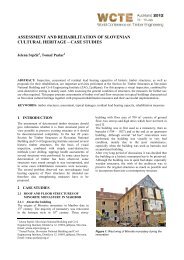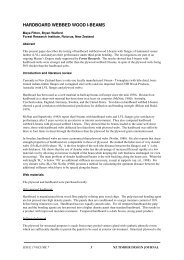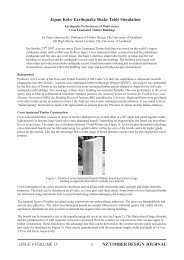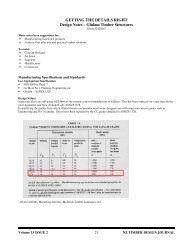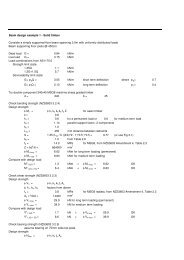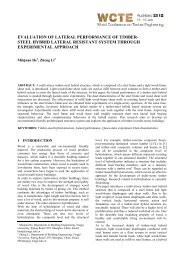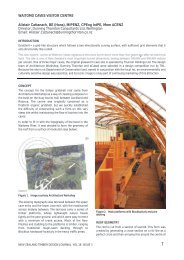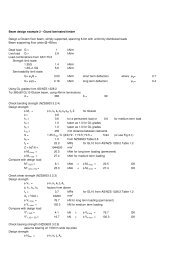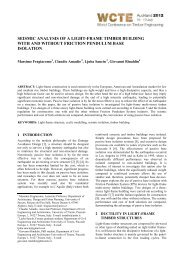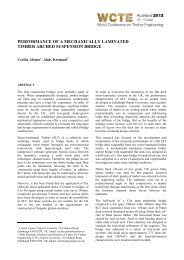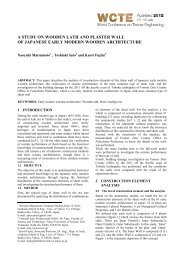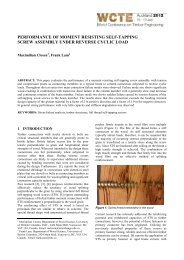Development of a design procedure for timber concrete composite ...
Development of a design procedure for timber concrete composite ...
Development of a design procedure for timber concrete composite ...
Create successful ePaper yourself
Turn your PDF publications into a flip-book with our unique Google optimized e-Paper software.
7. PROVISIONAL COMMENTS<br />
The Gamma <strong>procedure</strong> is a robust and safe <strong>design</strong><br />
approach. However, there are several aspects <strong>of</strong> it that<br />
are not yet fully understood. These parameters include:<br />
• shear strength <strong>of</strong> the <strong>concrete</strong> notch – effect <strong>of</strong> the<br />
coach screw,<br />
• flexural shear strength <strong>of</strong> the beam – effect <strong>of</strong> deep<br />
notch and use <strong>of</strong> the net area <strong>of</strong> the shear plane,<br />
• short-term serviceability – initial deflection and<br />
effect <strong>of</strong> <strong>concrete</strong> type and its curing,<br />
• long-term deflection – identification <strong>of</strong> the creep<br />
coefficient j 2 (global creep),<br />
• distribution and spacing <strong>of</strong> the notch – understanding<br />
<strong>of</strong> s min and s max .<br />
A better understanding <strong>of</strong> these parameters may<br />
contribute to the enhancement <strong>of</strong> the accuracy <strong>of</strong> the<br />
<strong>design</strong> and the optimisation <strong>of</strong> TCC solutions. One <strong>of</strong><br />
these parameters, that is, the long-term deflection is<br />
already under investigation at UTS. It is anticipated that<br />
UTS will examine the other parameters in a near<br />
future.<br />
Further work will also focus on making the <strong>design</strong><br />
<strong>procedure</strong> more user-friendly wherever possible whilst<br />
preserving the safety and functionality <strong>of</strong> the <strong>design</strong>.<br />
8. CONCLUSION<br />
Timber <strong>concrete</strong> <strong>composite</strong> (TCC) solutions have<br />
generated a great deal <strong>of</strong> interest in Australia and New<br />
Zealand over the last decade. This can be related to their<br />
satisfying the ultimate and serviceability expectations<br />
from modern architecture and <strong>design</strong>, which can help<br />
them capture important markets such as medium rise<br />
commercial and multi-storey residential buildings (up to<br />
eight stories). TCC structures also represent a genuine<br />
alternative to steel and <strong>concrete</strong> solutions.<br />
TCC structures utilise the mechanical properties <strong>of</strong><br />
both materials even though the <strong>composite</strong> action is<br />
only partial. As a result, they exhibit manifold<br />
complexity. The <strong>design</strong> methodology presented in this<br />
paper has adequately addressed the complexity <strong>of</strong> TCC<br />
structures, including the partial <strong>composite</strong> action<br />
provided by the connection, and imposes a<br />
comprehensive series <strong>of</strong> strength checks on the crosssection<br />
components, and serviceability checks with<br />
consideration <strong>of</strong> the long term per<strong>for</strong>mance <strong>of</strong> the<br />
structure.<br />
The proposed <strong>design</strong> <strong>procedure</strong> is an adaptation from<br />
the <strong>design</strong> <strong>procedure</strong> <strong>of</strong> EC5 and modifications have<br />
been made to suit local practices. Adapting this<br />
<strong>procedure</strong> to suit Australian practices has been a<br />
challenging exercise and where assumptions have had<br />
to be made due to uncertainties, these have erred on<br />
being conservative. These assumptions are also areas<br />
<strong>for</strong> further research in order to address the<br />
uncertainties associated with them. The <strong>design</strong><br />
<strong>procedure</strong> thus reflects and capitalises on research and<br />
development recently undertaken and in progress in<br />
Australia and New Zealand.<br />
9. REFERENCES<br />
[1] Ahmadi, B.H. & Saka, M.P. 1993, 'Behavior <strong>of</strong><br />
Composite Timber-Concrete Floors', Journal <strong>of</strong><br />
Structural Engineering, vol. 119, no. 11, pp. 3111-<br />
30.<br />
[2] AS 2009, Concrete Structures, vol. AS 3600–2009,<br />
Standards Australia, Homebush (NSW), Australia.<br />
[3] AS 2010, Timber Structures – Part 1: Design<br />
Methods, vol. AS 1720.1–2010, Standards<br />
Australia, Homebush (NSW), Australia.<br />
[4] AS/ANZ 2002a, Structural Design Actions, Part 0:<br />
General Principles, vol. AS/NZS 1170.0:2002,<br />
Standards Australia, Homebush (NSW), Australia.<br />
[5] AS/ANZ 2002b, Structural Design Actions, Part 1:<br />
Permanent, Imposed and Other Actions, vol. AS/<br />
NZS 1170.1:2002, Standards Australia, Homebush<br />
(NSW), Australia.<br />
[6] BCA 2010, BCA 2010: Building Code <strong>of</strong> Australia /<br />
Australian Building Codes Board Australian<br />
Building Codes Board, Canberra (ACT), Australia.<br />
[7] Ceccotti, A. (ed.) 1995, Timber-<strong>concrete</strong> <strong>composite</strong><br />
structures, Centrum Hout, Almere, The<br />
Netherlands.<br />
[8] Ceccotti, A. 2002, 'Composite <strong>concrete</strong>-<strong>timber</strong><br />
structures', Progress in Structural Engineering<br />
and Materials, vol. 4, pp. 264-75.<br />
[9] CEN 1995, Design <strong>of</strong> Timber Structures — General<br />
Rules and Rules <strong>for</strong> Buildings, vol. Eurocode 5<br />
(ENV 1995-1-1), European Committee <strong>for</strong><br />
Standardisation (CEN), Brussels, Belgium.<br />
[10] Crews, K. & Gerber, C. 2010, '<strong>Development</strong> <strong>of</strong><br />
<strong>design</strong> <strong>procedure</strong>s <strong>for</strong> <strong>timber</strong> <strong>concrete</strong> <strong>composite</strong><br />
floors in Australia and New Zealand', Proceedings<br />
<strong>of</strong> the 43rd Meeting <strong>of</strong> the 'International Council<br />
<strong>for</strong> Research and Innovation in Building and<br />
Construction', CIB - W18, Nelson, New Zealand.<br />
[11] Crews, K., Gerber, C., Buchanan, A. & Fragiacomo,<br />
M. 2008a, Innovative Engineered Timber Building<br />
Systems <strong>for</strong> non residential applications Report <strong>of</strong><br />
test specification and results - Protoype<br />
components <strong>for</strong> <strong>for</strong>est and wood products<br />
association University <strong>of</strong> Technology, Sydney.<br />
[12] Crews, K., Gerber, C., Choi, F.C., Buchanan, A. &<br />
Fragiacomo, M. 2007, Innovative Engineered<br />
Timber Building Systems <strong>for</strong> non residential<br />
applications Preliminary report (concept <strong>design</strong>)<br />
and literature review <strong>for</strong> Forest and Wood Product<br />
Association University <strong>of</strong> Technology, Sydney.<br />
14 NEW ZEALAND TIMBER DESIGN JOURNAL VOL 19· ISSUE 2



